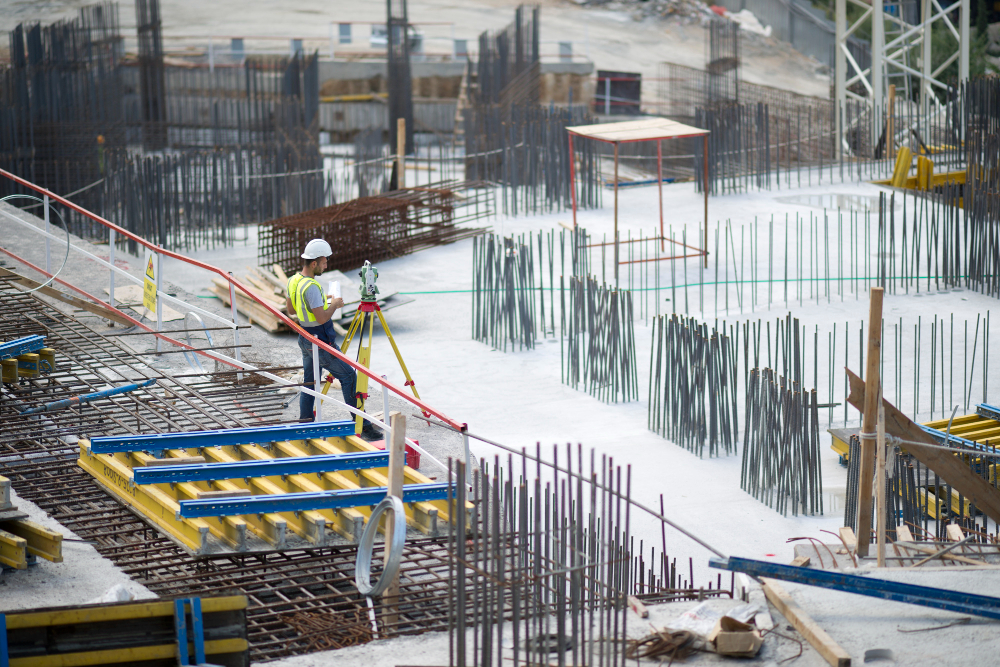Opportunities, Challenges, and Growth
Ontario’s building construction industry is a cornerstone of the province’s economy, driving infrastructure development, housing supply, and job creation. In 2025, the sector is navigating a dynamic landscape marked by robust growth projections, technological advancements, and persistent challenges like labor shortages and rising costs. At True North Positioning, a leader in construction data management and geospatial solutions, we’re closely attuned to these trends, providing precision survey control points to support Ontario’s ambitious projects. Drawing on industry insights, this blog explores the state of Ontario’s building construction industry in 2025, highlighting key drivers, obstacles, and what lies ahead.

A Resilient Industry Poised for Growth
Despite a marginal decline in 2023 and an expected dip in 2024 due to high interest rates, Ontario’s construction sector is rebounding and projected to grow steadily from 2025 through 2028, with activity remaining elevated through 2033. This optimism is fueled by significant investments in both residential and non-residential construction, supported by population growth and government initiatives.
Residential Construction: After a slowdown in housing starts (-7.1% in 2023), the residential sector is set to recover in 2025 as interest rates ease and demand for housing surges. Strong immigration, particularly in the Greater Toronto Area (GTA), is driving the need for multi-family units, with housing starts projected to increase through 2028. Renovation expenditures are also expected to grow continuously through 2033, as homeowners opt to upgrade existing properties.
Non-Residential Construction: The non-residential sector is a powerhouse, driven by a $180 billion pipeline of major projects, including manufacturing plants (e.g., Volkswagen in St. Thomas, Honda in Alliston), transit systems (e.g., Ottawa’s light rail), hospitals (e.g., Windsor Acute Care), and power plants. Capital expenditures in non-residential construction reached $126.5 billion in 2025, a 11.8% annual increase, reflecting robust activity in industrial, commercial, and institutional (ICI) projects.
Employment in the sector, which peaked at 596,000 workers in 2023, is expected to grow slightly over 2024–2026, with peaks in residential and non-residential employment projected for 2028 and 2029, respectively. However, the industry faces a complex economic picture, with opportunities tempered by significant hurdles.
Key Drivers of Growth
Infrastructure Investments: Government spending on infrastructure is a major catalyst, with projects like roads, bridges, schools, and public transit fueling non-residential growth. Notable examples include the NextStar manufacturing plant in Windsor and nuclear refurbishments in the GTA. These projects not only boost construction activity but also create jobs and stimulate local economies.
Population Growth and Housing Demand: Ontario’s population, bolstered by high immigration levels, is increasing demand for housing, particularly in urban centers. Provincial policies, such as the Housing Affordability Task Force, aim to expand housing stock, with a focus on multi-family units to accommodate newcomers.

Technological Advancements: The adoption of advanced technologies is transforming the industry. In 2025, 41% of contractors use advanced building materials (up from 35% in 2024), and 18% are leveraging artificial intelligence (AI) for predictive analysis, safety monitoring, and robotics. AI adoption is projected to rise to 21% within five years, with larger firms leading the way. Modular construction and robotics for tasks like bricklaying are also gaining traction, improving efficiency and reducing costs.
Sustainability and Green Building: Environmental priorities are shaping construction practices, with a focus on net-zero emissions and sustainable materials. Strengthened regulations and incentives are driving the use of energy-efficient systems, recycled materials, and renewable energy sources like solar panels, aligning with Canada’s climate goals.
Persistent Challenges
Despite the positive outlook, Ontario’s construction industry faces significant obstacles that require strategic solutions.
Labor Shortages: Labor market conditions remain strained, with 41% of contractors citing shortages as a top concern in 2025 (down from 48% in 2024). An aging workforce, with 19% (89,300 workers) expected to retire by 2033, exacerbates the issue. The industry needs to recruit 141,200 workers over the next decade, including 105,700 new entrants under 30, leaving a gap of 35,500 workers. Underrepresented groups, such as women (4% of tradespeople) and newcomers (27% of the workforce vs. 33% across all industries), offer recruitment opportunities, but progress is slow.
Rising Material Costs: While building cost inflation has moderated, 35% of contractors remain concerned about escalating material prices, particularly in the ICI sector, where inflation outpaces the provincial average of 1.7%. Economic uncertainties, including potential U.S. trade tariffs, could further drive costs.
Unemployment Fluctuations: Construction unemployment rose to 9.6% in January 2025, up from 6% in December, reflecting a 0.7% year-over-year employment decrease and a 3.2% labor force expansion. While below the 10.1% peak of January 2021, this volatility highlights the sector’s sensitivity to economic shifts.
Regulatory Changes: The new 2024 Ontario Building Code, effective January 1, 2025, introduces significant revisions to align with National Construction Codes, aiming to enhance safety, reduce regulatory burdens, and support housing construction. However, adapting to these changes, including a three-month transition period, poses challenges for contractors, particularly smaller firms.
Regional Dynamics
Ontario’s five regions—Central, Eastern, GTA, Northern, and Southwestern—each face unique conditions:
GTA: Driven by large-scale public transit, hospital, and nuclear projects, but with lower contractor optimism (56% vs. 73% outside GTA) due to high costs and competition.

Central Ontario: Benefits from GTA out-migration, with residential growth expected post-2025.
Eastern Ontario: Dominated by Ottawa’s light rail and federal projects, with hospital construction boosting growth through 2028.
Southwestern Ontario: Home to major manufacturing plants (e.g., Volkswagen) and the Windsor Acute Care Hospital, with strong employment growth projected.
Northern Ontario: Influenced by mining and utility sectors, with projects like the Thunder Bay Correctional Complex driving growth from 2025–2027.
Limited interregional mobility, due to high demand across all regions, complicates labor allocation, making precise project planning critical.
The Role of True North Positioning
 At True North Positioning, we support Ontario’s construction boom by providing precise survey control points that ensure project accuracy. Our GNSS, total stations, and 3D laser scanning services, with 1–3 mm accuracy, are integral to projects like highways, hospitals, and manufacturing plants. By integrating with BIMand CAD, we help contractors avoid costly errors, streamline workflows, and meet tight deadlines. Our 24/7 support and cloud-based data solutions empower Ontario’s builders to tackle complex projects with confidence.
At True North Positioning, we support Ontario’s construction boom by providing precise survey control points that ensure project accuracy. Our GNSS, total stations, and 3D laser scanning services, with 1–3 mm accuracy, are integral to projects like highways, hospitals, and manufacturing plants. By integrating with BIMand CAD, we help contractors avoid costly errors, streamline workflows, and meet tight deadlines. Our 24/7 support and cloud-based data solutions empower Ontario’s builders to tackle complex projects with confidence.
Looking Ahead: A Bright but Challenging Future
Ontario’s building construction industry in 2025 is a story of resilience and opportunity. With a robust project pipeline, technological innovation, and supportive policies, the sector is set for growth through the late 2020s. However, addressing labor shortages, managing costs, and adapting to regulatory changes will be critical to sustaining momentum. By leveraging advanced tools, diversifying the workforce, and prioritizing sustainability, Ontario’s construction industry can overcome challenges and continue to shape the province’s future.
Ready to Build with Precision?
True North Positioning is here to support your next project with cutting-edge survey solutions. Contact us at truenorthpositioning.com or call (416) 562 4559 for a free consultation. Let’s build Ontario, together.
